[ad_1]
In today’s digital age, SEO has become the backbone of online visibility and success. Businesses and content creators are constantly seeking ways to stand out in the competitive online landscape and capture the attention of their target audience.
One effective strategy that has gained significant importance is obtaining featured snippets in search engine results pages (SERPs). But how exactly do you go about optimising your website for featured snippets and why are they so sought after?
This is what our blog will go through. Whether you’re a business owner or content creator, understanding the importance and impact of featured snippets can be an absolute game changer.
So, if you’re ready to take your SEO game to the next level and harness the power of featured snippets, let’s dive in and explore the strategies that can help you reach the pinnacle of search engine results!
What exactly are featured snippets?
Featured snippets, also known as position zero or answer boxes, are a type of search result that appear at the very top, which provide users with direct and concise answers to specific questions.
They aim to provide users with quick and accurate responses to their search queries, making it convenient and efficient for them to find the information they need.
This enhances the user’s search experience and on the other hand, featured snippets can significantly boost their online visibility, credibility, and organic traffic. Occupying the top spot above traditional organic search results can establish your brand as an authoritative source and drive targeted traffic to your website.
It’s worth noting that featured snippets can reduce the number of clicks to your website, but this is because the user may find all the information they require from the featured snippet, reducing the need for them to click through.
However, the benefits of increased organic visibility, authority and brand exposure can outweigh the potential loss of clicks.
How do featured snippets work?
Featured snippets are generated by search engines through a combination of algorithmic analysis and content selection. A brief process is as follows:
- Search engine’s algorithms analyse a query’s intent and context to understand the user’s specific information needs.
- They then crawl and index web pages to gather and store a vast amount of content, including its relevance, structure and formatting.
- Indexed content is then evaluated to determine its relevance and usefulness for specific search queries.
- Based on the evaluated content, search engines extract the most relevant and concise information to create featured snippets.
- Search engines then present the selected information in a visually enhanced format, such as a box, paragraph, list, table, or video, depending on the nature of the content and the query.
- Featured snippets are then displayed prominently at the top of the SERPs and their ranking is determined based on various factors, including the relevance, quality, and authority of the source content.
It’s important to note that featured snippets are dynamic and can change over time as search engines continuously analyse new content and update featured snippets to ensure the most relevant and up-to-date information is presented to users.
Types of featured snippets
There are six main types of featured snippets, with some appearing much more frequently than others.
1. Paragraph
The majority of featured snippet opportunities are paragraph featured snippets, which presents a brief description/answer that directly answers or relates to the user’s search query.
Using text pulled from a <p> element, these might quickly answer a question or give a brief overview of a topic that requires further research, like in the below example:
2. List
List featured snippets come in either bulleted, unordered form, or in the form of a numbered list. List featured snippets tend to use content from within <ol> or <ul> elements on your page.
Numbered list snippets are returned when the answer to the query the user is posing can be broken down into a multi-step process:
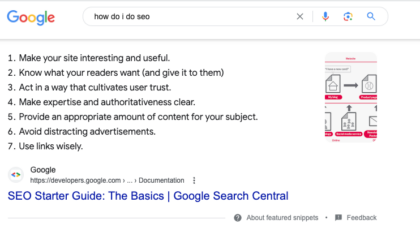
3. Table
Generally used when there’s a table of content on the page that contains various sets of data, table featured snippets present that information to the user straight away on the SERP.
However, the table featured snippet seems to be becoming more elusive. I struggled to find any examples of Google displaying a table for searches around things like pricing, rates, or sets of data.
In some cases, the table looks to have been replaced with a richer result – for example, below Google has pulled data from across the web to provide a richer result for ‘most expensive UK city’: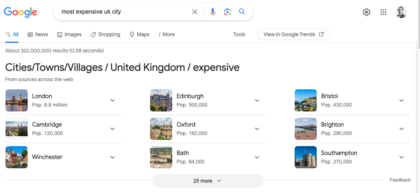
Which looks undeniably better than the example used in this blog when it was originally published in 2017: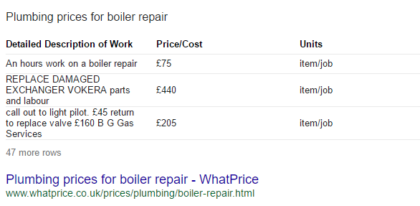
4. Video
Google will show a Youtube video in the featured snippet position if it deems it to be the best way to answer a user’s query.
This is mainly the case with how-to searches, such as DIY content: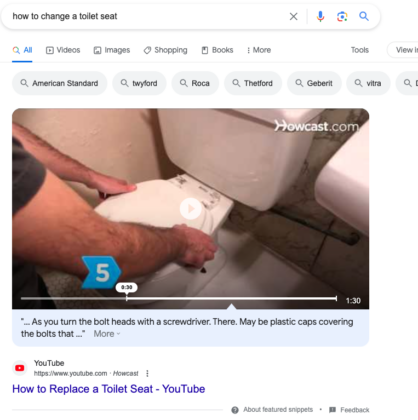
If you’re trying to rank higher on the SERPs for your Youtube videos, ensure your videos are optimised for the best chance of appearing in the featured snippet position.
On the flip side, if you see videos are ranking in the SERPs for a lot of your target terms but you’re not currently creating any video content, you might want to start factoring that into your organic strategy.
5. Carousel
A carousel featured snippet displays a series of images or cards that users can scroll through. This format is commonly used for queries related to products, recipes, or other visual content, such as movies like our Chris Hemsworth below:
6. FAQs
FAQ featured snippets are a specific type of featured snippet that presents a question-and-answer format, designed to provide concise answers to common questions related to a specific topic.
These usually appear in the “people also ask” section of a results page like: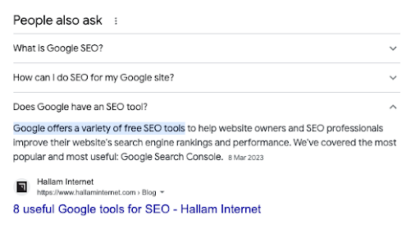 It’s important to note that not all queries will trigger a featured snippet, and the type of snippet shown can vary based on the search intent and content available. Search engines aim to provide the most relevant and helpful information to users, selecting the appropriate format for each query.
It’s important to note that not all queries will trigger a featured snippet, and the type of snippet shown can vary based on the search intent and content available. Search engines aim to provide the most relevant and helpful information to users, selecting the appropriate format for each query.
Understanding the different types of featured snippets can help content creators tailor their content to increase the chances of being selected for a particular format. By structuring your content in a way that aligns with featured snippet types, you can improve your visibility and increase the likelihood of earning a coveted position zero spot in search results.
What are the benefits of featured snippets?
There are lots of benefits of featured snippets, including:
Improved user experience
Featured snippets are designed to provide information users require quickly and by providing concise and relevant information directly on the SERPs, featured snippets save time and effort, increasing overall user experience and satisfaction.
Increased visibility
Featured snippets’ prime position provides enhanced visibility for your content, making it more likely to catch the attention of users and stand out among competitors.
High click through rate (CTR)
With a much larger visual presence right at the top of the SERPs, maintaining the featured snippet position can help improve CTR as the user may then want to click on and explore further content or read more information.
This is because depending on the search query, the featured snippet space may not physically be able to display all the information needed and so a user might have to click through anyway.
However, as explained earlier, there’s an argument that as you’re presenting the information to the user directly in the SERP, they’re disinclined to click through to your site and so featured snippets can sometimes actually reduce click rates.
This relatively recent study found that featured snippets did indeed drive higher than average CTRs.
It’s understandable that you may be sceptical about whether a featured snippet is the right move for your business, and the new change brought about in 2020 prevents you from being listed lower down on the SERP page if you’re in the featured snippet. Ultimately though, the featured snippet grants you the ultimate SERP presence.
Enhanced brand authority
Occupying the coveted position zero in search results establishes your brand as an authoritative source of information. Users perceive websites featured in snippets as trusted and reliable, which can help build trust and credibility for your brand.
This can, in turn, position you as an industry expert or thought leader. This can attract more attention, media coverage, and opportunities for collaborations or partnerships.
Competitive advantage
Securing a featured snippet can give you a competitive edge over other websites that appear in traditional organic search results. Snippets provide a unique opportunity to showcase your content and differentiate yourself from competitors, driving more traffic to your website.
Voice search compatibility
Additionally, voice answers from devices such as Alexa, Google Assistant and Siri, tend to use the content within featured snippets.

How to optimise your website for featured snippet positions
Optimising your website for featured snippets requires strategic content creation and technical implementation. Here are some key steps to help you optimise your website for a higher chance of appearing in featured snippets:
1. Identify relevant search queries
Before creating any content, it’s important to identify and research common queries that people are searching for that relate to your industry, products, services and/or niche.
There are certain terms, phrases and long tail keywords that have a higher chance of triggering featured snippets, such as frequently asked questions or topics that require concise and structured content or answers like recipes and how-tos.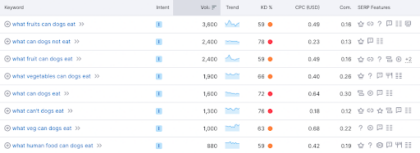
It’s also worth checking these queries, phrases and terms on the SERPs themselves to see if they already rank for featured snippets as that way you can identify who you’d be competing against.
2. Create comprehensive and valuable content
Once you’ve identified a target keyword or topic, next you’ll want to craft high-quality, comprehensive content that directly answers the identified queries.
Ensure your content provides clear and concise answers, ideally in a format suitable for snippets, such as paragraphs or lists. Anticipate the specific needs and intentions of users searching for those queries.
3. Utilise structured data
Now that you have created your content, make sure that you implement structured data markup, which will help search engines understand the content and structure of your page.
Ensure that you use the appropriate schema markup for specific types of content, such as article schema for blogs and FAQ schema for pages that have questions and answers.
If it’s a paragraph snippet you’re after, write your answer within a <p> tag. If it’s a list, use the <ul> tag. Chuck a table on your page and mark it up with table structured data if you’re aiming for a table to display in the SERPs.
These are some best practices to follow in 3 easy steps, but here are some more tips and tricks:
- Provide clear and direct answers – you may want to start with a brief summary or introduction, followed by a comprehensive response. Incorporate relevant keywords naturally within your content, focusing on the user’s intent and providing helpful information.
- Use bullet points and lists – this helps search engines identify the content structure and increases the chances of your content appearing as a list-type featured snippet.
- Answer multiple related questions – consider creating content that answers multiple related questions within a single page. This increases the likelihood of your page being selected for multiple featured snippets, broadening your visibility and driving more traffic.
- Optimise your meta descriptions – if they accurately summarise your content, they can entice users to click through to your website, influence the overall CTR and increase user engagement.
- Continuously monitor and refine – analysing which queries trigger snippets and assessing user engagement, you can refine your content accordingly by enhancing the clarity and relevance of your answers.
Remember that featured snippets are determined by search engines, and there’s no guaranteed way to secure them.
However, by focusing on providing valuable and well-structured content that aligns with user intent, you can increase your chances of being selected for featured snippets and enjoy the associated benefits of increased visibility and traffic.
Featured snippet FAQs
Do I have to pay for featured snippets?
No, website owners do not have to pay for featured snippets as they are organic search results that are determined by search engine algorithms based on relevance, quality, and other factors. They are not directly influenced by advertising or paid placements.
However, it’s worth noting that optimising your content for featured snippets may require investing time and resources in creating high-quality, relevant content and implementing SEO best practices.
While there are no direct costs associated with appearing in featured snippets, the overall effort and investment in content creation and on-page optimisation are necessary to increase your chances of being featured.
Can I opt out of featured snippets?
Yes, it is possible to opt out of having your content displayed in featured snippets.
Search engines like Google allow website owners to indicate their preference through a specific HTML tag called the “nosnippet” tag.
By including this tag in the HTML code of your web pages, you can signal to search engines that you do not want your content to be used for featured snippets.
However, it’s important to note that using the nosnippet tag may also impact other types of search result enhancements, such as rich snippets.
Additionally, search engines ultimately have the discretion to decide whether or not to honour the request, so opting out does not guarantee that your content will be excluded from featured snippets.
Why would I want to opt out of featured snippets?
Website owners may choose to opt out of featured snippets for reasons such as wanting users to click through to their website for better control over engagement and monetisation, concerns about the loss of context in the summarised snippets, protecting intellectual property rights, or addressing competitive concerns.
However, opting out means potentially missing out on the benefits of increased visibility and potential traffic that featured snippets offer.
Are featured snippets the same as structured data?
Featured snippets and structured data are not the same, but they are related.
Featured snippets are the highlighted answers displayed at the top of search results, while structured data refers to a specific format of marking up content using schema.org vocabulary.
Structured data helps search engines understand and categorise content more effectively, making it easier for them to generate featured snippets. While structured data can increase the chances of content being selected for snippets, it doesn’t guarantee their appearance.
Structured data is a valuable SEO practice that provides more context to search engines, while featured snippets are the resulting displayed answers in search results.
What’s the difference between a rich snippet and featured snippet?
There is a slight difference. Rich snippets are enhanced search results that provide additional information and visual enhancements within the organic search results, using structured data markup to display details like ratings, prices, and reviews.
On the other hand, featured snippets are positioned at the top of the search results and aim to provide direct answers to user queries, displayed in a concise format without requiring users to click through to a website.
While rich snippets provide more context and entice users to click, featured snippets prioritise providing immediate answers.
How do I track and measure featured snippets?
Tracking and measuring featured snippets can be challenging since search engines don’t provide specific tools or metrics for this purpose. However, there are several approaches you can take to gain insights and assess the performance of your content in featured snippets:
- Manual search and monitoring
- Use Google Analytics monitor changes in traffic, CTRs and engagement metrics for the pages that have reached featured snippets
- You can do the same with clicks and impressions for queries that have featured snippets in Google Search Console
- Use rank tracking tools, such as Semrush, which has recently been updated to show featured snippet insights
Can I optimise my existing content to appear in featured snippets, or do I need to create new content specifically for that purpose?
You can certainly optimise your existing content to increase its chances of appearing in featured snippets. While creating new content with featured snippets in mind can be beneficial, it is not always necessary as it’s sometimes easier and quicker to improve existing content.
Final thoughts
In this comprehensive guide to featured snippets, we explored what featured snippets are, how they work, why they’re important for SEO and how to optimise for them, all crucial to understanding the importance of featured snippets for website owners and marketers seeking to enhance their search visibility.
Trying to keep up with the world of search is complex and tiring, but featured snippets aren’t going anywhere (for now), which means that they’re currently dominating SERPs. We hope you found this guide helpful, but if you have any questions, please don’t hesitate to contact us.
[ad_2]
Source link









